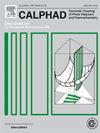结合模拟计算和 CALPHAD 方法对 Ce-Rh 系统进行热力学评估
IF 1.9
3区 材料科学
Q4 CHEMISTRY, PHYSICAL
Calphad-computer Coupling of Phase Diagrams and Thermochemistry
Pub Date : 2024-09-26
DOI:10.1016/j.calphad.2024.102747
引用次数: 0
摘要
本研究中的标准形成焓是通过 DFT(密度泛函理论)第一性原理计算得出的,适用于 Ce-Rh 系统中的金属化合物。从文献中获得的热力学数据和相图信息被用作 Ce-Rh 的 CALPHAD 类型优化和 Thermo-Calc 软件的输入:Ce-Rh 相图包含七种金属间化合物:Ce7Rh3、Ce5Rh3、Ce3Rh2、Ce5Rh4、CeRh、CeRh2 和 CeRh3。所有这些相都是化学计量的;有关相平衡的相关模型可以准确地描述全部成分范围和以 CeRh 为关联物输入的热力学数据。所有金属间化合物的热力学参数都是根据 Neumann-Kopp 原理建模的。所有化合物都采用了各吉布斯能随温度变化的贡献值。最终,获得了一套自洽的 Ce-Rh 系统热力学参数。本文章由计算机程序翻译,如有差异,请以英文原文为准。
Thermodynamic assessment of the Ce-Rh system by the combination of ab-initio calculations and the CALPHAD approach
The standard enthalpies of formation in this work have been measured calculated by First -principles calculations within DFT (density functional theory) for the metal compounds in the Ce-Rh system. Thermodynamic data and phase diagram information obtained from the literature were used as the input for a CALPHAD-type optimization and Thermo-Calc software of the Ce-Rh.
The Ce-Rh phase diagram contains seven intermetallic compounds: , , , , , and . All these phases were stoichiometric; The associated model concerning the phase equilibria, could accurately describe the full compositional range and the thermodynamic data input with as associate. The thermodynamic parameters of all intermetallic compounds were modeled by the Neumann-Kopp principle. The value of the temperature-dependent contributions to the individual Gibbs energies was used for all compounds. A fairly good agreement with all values of the enthalpies of formation calculated in this work using the VASP and data available in the literature. ultimately, a set of self-consistent thermodynamic parameters for the Ce-Rh system was obtained.
求助全文
通过发布文献求助,成功后即可免费获取论文全文。
去求助
来源期刊
CiteScore
4.00
自引率
16.70%
发文量
94
审稿时长
2.5 months
期刊介绍:
The design of industrial processes requires reliable thermodynamic data. CALPHAD (Computer Coupling of Phase Diagrams and Thermochemistry) aims to promote computational thermodynamics through development of models to represent thermodynamic properties for various phases which permit prediction of properties of multicomponent systems from those of binary and ternary subsystems, critical assessment of data and their incorporation into self-consistent databases, development of software to optimize and derive thermodynamic parameters and the development and use of databanks for calculations to improve understanding of various industrial and technological processes. This work is disseminated through the CALPHAD journal and its annual conference.

 求助内容:
求助内容: 应助结果提醒方式:
应助结果提醒方式:


